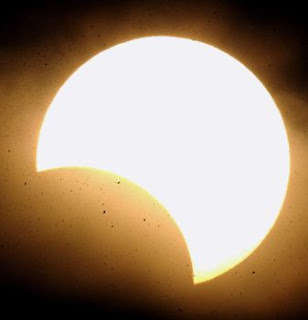Catch a glimpse
Eclipses should never be watched with the naked eye, as it is extremely dangerous for the eyes. Neither should an eclipse be watched through cooling glasses or sun glasses. A simple way of observing an eclipse is as follows: Take two pieces of plain cardboard and punch a hole of about 2mm in one of them. Hold this a few centimetres above the other piece, which acts as a screen. Stand with your back to the sun so that the sun's rays are above your shoulder. You can see the image of the eclipse on the screen.
Or, visit your nearest planetarium, which will have the right equipment for you to view the eclipse.
Try this simple experiment...Stand facing a light-bulb, and hold a coin close to one of your eyes (keeping the other eye closed). If you bring the coin close enough to your eye, it can block the light from the bulb almost completely. As you move the coin away from your eye, you can see more and more of the light, till you can see the bulb itself.
While this is easy enough to do, imagine this happening on an astronomical scale as during a solar eclipse. The moon, which revolves around the earth, is much closer to the earth (approximately 385,000 kms away) than the sun is (approximately 149 million kilometres) but the sizes of the sun and the moon when seen from the earth are the same — an almost magical coincidence!
Watch the sky
Because the moon's orbit is inclined at about five degrees to that of the earth, the moon can come in front of the sun only where the orbits of the moon and the earth intersect. These points are called the ‘nodes' of the moon's orbit.
When the moon in its journey around the earth arrives at a node, it blocks the rays of the sun from striking the earth, causing a total solar eclipse. When it moves away from the node, the moon will cover only a part of the sun, causing a partial eclipse.
An annular eclipse is when the moon does not cover the entire disk, allowing a thin rim of sunlight to be visible around the edge. On an average, there are two to five solar eclipses in a year. Eclipses last only a few minutes, as they can be seen only from the small portion of the earth on which the moon's shadow is cast.
On January 15, an annular eclipse will occur over India, starting at about 13: 23 IST, which is to last around 10.4 minutes., and a maximum of 11 minutes and 7 seconds over the Indian Ocean. An eclipse can be an inspiring event to watch, reminding us of the wonder that the universe is. Don't miss it!
